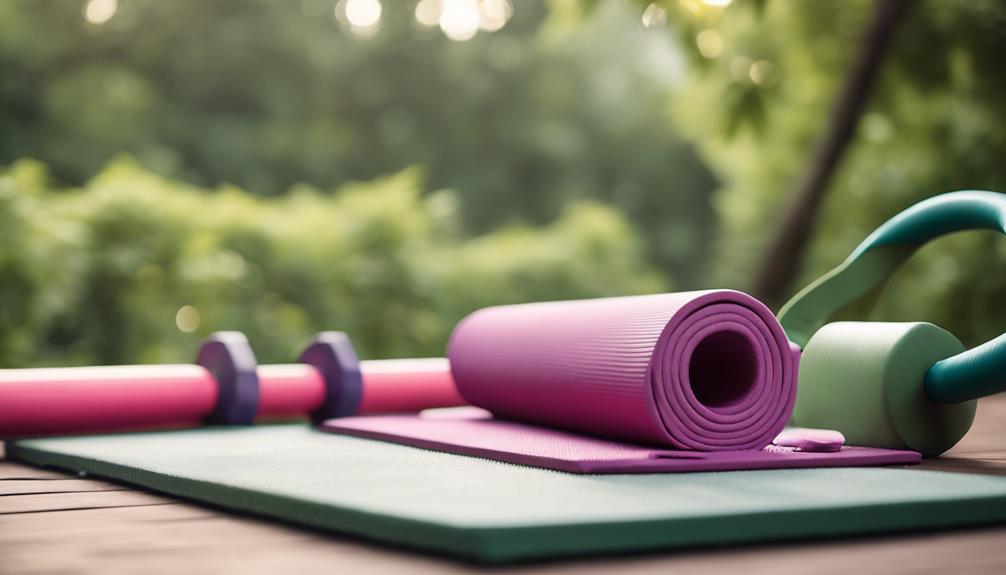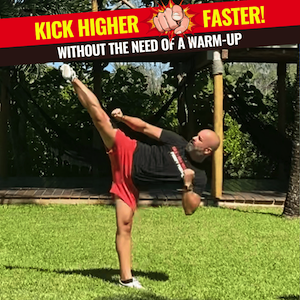As you hit 40, you need to train smarter, not harder. Start by evaluating your fitness level and setting realistic goals that focus on muscle maintenance, functional mobility, and injury prevention. You'll want to prioritize strength training, aiming for at least two sessions per week, and incorporate low-impact cardio, like swimming or cycling, to reduce joint stress. Don't forget to balance strength with flexibility exercises and prioritize recovery time. By making consistency a habit and monitoring your progress, you'll be on track to a healthier, more energetic you. Now, it's time to take the next step towards a smarter training approach.
Assess Your Fitness Level
Take a proactive approach to understanding your body's capabilities by conducting an extensive fitness evaluation, which will give you a clear picture of your strengths and weaknesses regarding strength, stability, mobility, and cardiorespiratory fitness.
As you age, it's vital to evaluate your fitness level regularly, especially after 40. You'll start to notice a decline in muscle mass, which can decrease by 3-8% per decade starting in your 30s. This loss accelerates after age 60, making it important to review and adjust your strength training regimen regularly.
Don't wait until you notice significant changes in your body; take control by evaluating your fitness level now. Focus on strength training to maintain or even increase muscle mass.
A thorough assessment will also help you identify areas that need improvement, such as stability, mobility, or cardiorespiratory fitness. By understanding your body's capabilities, you can tailor your workouts to accommodate its changing needs, preventing future physical limitations and ensuring you stay healthy and active as you age.
Regular evaluations will guide your exercise intensity and frequency, helping you make the most of your workouts and maintain a healthy, strong body.
Focus on Muscle Maintenance
Your 40s mark a pivotal point in your fitness journey, as muscle mass begins to decline more noticeably. You're not alone in this struggle, but you can take proactive steps to slow down this process.
Focus on muscle maintenance through resistance training, which can help preserve muscle mass and improve metabolic health. By incorporating strength training at least twice a week, you'll not only maintain muscle mass but also enhance bone density, reducing the risk of osteoporosis and fractures.
Bodyweight exercises are an excellent option as they minimize strain while effectively building strength. Don't forget to fuel your muscles with adequate protein intake – aim for 1.0 to 1.2 grams of protein per kilogram of body weight daily.
Here are the benefits you can look forward to:
- You'll stay strong and independent, maintaining functional mobility as you age.
- Your metabolism will stay fired up, supporting weight management and overall health.
- You'll reduce your risk of chronic diseases, such as osteoporosis and diabetes.
- You'll feel empowered and confident, taking control of your health and wellbeing.
Incorporate Low Impact Cardio
As you focus on maintaining muscle mass through resistance training, don't forget to balance your routine with low-impact cardio exercises that are gentle on your joints.
After 40, your joints undergo significant changes that can make high-impact activities more challenging. Low-impact cardio exercises like swimming, cycling, and walking reduce stress on your joints while providing effective cardiovascular benefits.
By incorporating these activities into your routine, you'll maintain or improve your VO2 max, which typically declines with age, enhancing your overall energy and endurance.
You'll also promote weight management and fat loss, essential for countering age-related metabolic slowdowns. Activities like Pilates and yoga not only improve cardiovascular fitness but also enhance flexibility and stability, reducing the risk of falls and injuries.
Aim for at least 150 minutes of moderate-intensity low-impact cardio weekly to support heart health and overall longevity. This will allow you to accommodate your body's changing needs as it ages.
Prioritize Recovery Time
Recovery time becomes a critical component of your training routine after 40, requiring a more thoughtful and intentional approach. As you age, your body takes longer to repair and rebuild muscle tissue, making it essential to prioritize recovery time to avoid overtraining and prevent injuries.
You need to limit high-intensity workouts to no more than twice a week, allowing adequate muscle repair and rebuilding.
To make the most of your recovery time, consider the following strategies:
- Give your body time to repair and rebuild by incorporating rest days and lighter training sessions into your routine.
- Engage in active recovery methods, such as light stretching or yoga, to enhance circulation and promote muscle recovery.
- Make sleep a priority, aiming for at least eight hours of quality sleep each night to greatly improve overall performance and recovery rates.
- Support your body's recovery with proper nutrition, including a balance of carbohydrates and protein within 30 minutes of training.
Balance Strength and Flexibility

Beyond the age of 40, maintaining a balance between strength and flexibility becomes a critical aspect of your training routine. As you age, your mobility decreases and stiffness increases, making flexibility exercises essential for injury prevention.
To achieve this balance, incorporate dynamic movements like lunges and leg swings into your routine, which improve flexibility and enhance strength simultaneously. Don't rely solely on static stretching; instead, focus on compound movements that promote full-body engagement during strength training.
Aim to include flexibility exercises at least 2-3 times per week alongside strength training to support recovery, reduce muscle tightness, and improve overall functional movement.
A balanced training split is key: allocate approximately 60% of your workouts to strength training and 40% to flexibility exercises. This will optimize both muscle health and joint function as you age.
Manage Nutrition and Hydration
As you focus on managing nutrition and hydration, it's vital to develop a strategic plan that aligns with your workout schedule.
Properly timing your meals and hydration can greatly influence your energy levels and performance, so it's important to prioritize balanced meals and hydration at the right moments.
Nutrition Planning Strategies
Someone hitting their 40s often realizes that their nutrition plan needs a bit of a reboot. As you age, your body requires different fuel to maintain muscle mass, recover from workouts, and support overall health.
That's where nutrition planning strategies come in – a thoughtful approach to eating that supports your fitness goals.
To create an effective plan, focus on whole foods that provide a balanced mix of protein, complex carbohydrates, and healthy fats. Aim for 1.2 to 2.0 grams of protein per kilogram of body weight daily to support muscle repair and growth.
Here are some key considerations:
- Listen to your body: Pay attention to how different foods make you feel and adjust your plan accordingly.
- Eat to recover: Consume carbohydrates and protein within 30 minutes post-exercise for best recovery and energy replenishment.
- Fuel your workouts: Plan meals around your workout schedule to guarantee you're properly fueled for each session.
- Don't forget the extras: Consider including supplements like vitamin D and calcium if your dietary intake is insufficient.
Hydration Timing Importance
Your body's hydration needs change as you age, and when you hit your 40s, it's more essential than ever to get your hydration timing right. Proper hydration before, during, and after exercise is critical for maintaining performance. Even mild dehydration can negatively impact endurance and strength.
To guarantee ideal hydration levels, aim to drink at least 16-20 ounces of water 1-2 hours before exercising. Include fluids with electrolytes, particularly sodium and potassium, to enhance hydration efficiency, especially during prolonged workouts or hot weather.
During workouts lasting longer than an hour, drink 7-10 ounces of fluid every 10-20 minutes to maintain hydration and electrolyte balance. Post-exercise, rehydrate with approximately 16-24 ounces of water or a recovery drink for every pound of body weight lost during the workout.
By paying attention to hydration timing, you'll support recovery and maintain performance. Make hydration a priority by incorporating it into your routine, just as you'd any other aspect of your training. By doing so, you'll guarantee your body is properly fueled to tackle your workouts and aid in recovery.
Get your hydration timing right, and you'll be on your way to ideal performance.
Set Realistic Fitness Goals

As you set realistic fitness goals after 40, you'll want to define achievable objectives that align with your current fitness level and lifestyle.
Take an honest assessment of your strengths and weaknesses in areas like strength, stability, mobility, and cardiorespiratory fitness to identify where you can make the most progress.
Define Achievable Fitness Objectives
Reaching 40 can be a wake-up call, prompting you to reevaluate your fitness priorities. As you age, it's important to define achievable fitness objectives that cater to your unique strengths and limitations.
Setting realistic goals involves acknowledging any age-related declines in muscle mass and endurance, and tailoring your objectives accordingly.
When defining your achievable fitness objectives, aim for specific, measurable goals that enhance motivation and track progress.
Consider the following:
- Focus on functional mobility to maintain independence and quality of life
- Improve cardiovascular health to reduce the risk of chronic diseases
- Enhance strength and flexibility to boost overall well-being
- Prioritize injury prevention to guarantee sustainable progress
Assess Current Fitness Level
Once into your 40s, a thorough assessment of your current fitness level becomes essential to setting realistic fitness goals. You need to understand where you stand regarding strength, stability, mobility, and cardiorespiratory fitness to create an effective training plan.
As you age, muscle mass decreases by 3-8% per decade, starting in your 30s. This makes it imperative to prioritize muscle maintenance through resistance training.
Your assessment should also consider the decline in VO2 max with age. This means incorporating aerobic activities to enhance cardiovascular health and endurance is crucial. Aim for a balanced routine that includes at least 150 minutes of moderate aerobic activity and strength training for all major muscle groups twice a week.
Don't forget to adjust your goals to account for increased recovery time and a greater risk of injury with age. Focus on sustainable progress rather than extreme measures. By doing so, you'll be able to set realistic fitness goals that cater to your needs and abilities, ensuring a safe and effective training journey.
This assessment will be the foundation of your training plan, helping you make informed decisions about your fitness regimen.
Create Sustainable Workout Plan
Crafting a sustainable workout plan is an art of balance, requiring a deep understanding of your body's unique needs and limitations. As you aim to set realistic fitness goals, you'll need to assess your current levels in strength, stability, mobility, and cardiorespiratory fitness to identify areas for improvement. This means being honest about where you're and where you want to be.
With this foundation, you'll be able to create a workout plan that's tailored to your needs. Consider the following essential elements:
- Aim for at least 150 minutes of moderate aerobic activity weekly, with strength training on two non-consecutive days to cover all major muscle groups.
- Incorporate a balanced mix of hard and easy workouts to allow for adequate recovery while promoting fitness gains and preventing injury.
- Focus on maintaining a moderate rep range of 8-12 reps in strength training to support muscle preservation.
- Prioritize consistency over intensity, as shorter, more frequent sessions can yield better long-term results.
Incorporate Functional Training
Regularly incorporating functional training into your routine is a game-changer as you age. You'll enhance your everyday movement patterns, making activities like lifting, bending, and climbing stairs easier and safer.
Functional training exercises, such as lunges with balance and the world's greatest stretch, improve stability, mobility, and coordination – essential for preventing falls and injuries.
As you engage in multi-joint movements during functional training, you'll preserve muscle mass and maintain strength, which can decline by 3-8% per decade after 30. This type of training also helps with balance, greatly reducing the risk of falls, a common concern for individuals over 40.
The best part? Functional training can be adapted to various fitness levels, allowing you to promote longevity and quality of life while engaging in workouts that mimic real-life activities.
Monitor Progress and Adjust

As you train after 40, it's crucial to track key performance indicators, such as strength, stability, mobility, and cardiorespiratory fitness, to identify areas that need improvement.
You'll also need to adapt to your body's natural changes, including longer recovery times, which may require adjusting the intensity and frequency of your workouts.
Track Key Performance Indicators
In your pursuit of ideal fitness after 40, tracking key performance indicators (KPIs) is essential to making informed decisions about your training plan. By monitoring metrics like VO2 max, power output, and recovery times, you'll gain valuable insights into your progress and can adjust your training plan effectively.
Utilizing fitness apps or wearable technology can help you monitor metrics like heart rate variability and training load, enabling smarter training decisions and preventing overtraining.
To get the most out of tracking KPIs, focus on the following:
- Set specific, measurable goals based on your baseline assessments to motivate yourself and provide clear benchmarks for progress.
- Track recovery metrics, such as sleep quality and muscle soreness, to guide adjustments in workout intensity and frequency.
- Regularly reassess your physical capabilities, such as strength levels and flexibility, to make timely modifications to your routines.
- Leverage technology to monitor your progress and receive actionable feedback to optimize your training.
Adapt to Body Changes
Your 40s and beyond can be a transformative time, filled with new physical realities that require intentional training adjustments. As you age, your muscle mass decreases, and your body undergoes natural changes that impact your fitness.
To adapt, regularly assess your fitness levels across strength, stability, mobility, and cardiorespiratory fitness. This will help you identify areas needing adjustment. Monitor your muscle mass closely, as it decreases by 3-8% per decade starting in your 30s. Incorporate resistance training to mitigate this loss and enhance functional mobility.
Adapt your workout routines to include lower intensity and higher rep ranges (8-12 reps) to minimize injury risk while preserving muscle mass and strength. You may also notice longer recovery times, so limit high-intensity workouts to twice a week.
Ascertain your nutrition supports your training changes by focusing on adequate protein intake for muscle repair and incorporating antioxidant-rich foods to reduce inflammation. With these adjustments, you'll be able to maintain or even lose body weight and stay on track with your fitness goals.
Make Consistency a Habit
Developing a consistent workout routine is essential for maintaining and improving overall fitness after 40. You need to make exercise a non-negotiable part of your daily routine, just like brushing your teeth or taking a shower. Consistency is key to seeing results and feeling the benefits of regular physical activity.
By establishing a consistent workout schedule, you'll not only improve your physical health but also boost your mental well-being. Here are just a few reasons why consistency matters:
- You'll be more likely to stick to your routine, even when life gets in the way.
- You'll see tangible results from your efforts, which will motivate you to keep going.
- You'll reduce your risk of chronic diseases, such as heart disease and diabetes.
- You'll feel more energized and confident, which will translate to other areas of your life.
Aim to do at least 150 minutes of moderate aerobic activity each week, and incorporate strength training, cardio, and flexibility work into your routine.
In Summary
As you forge ahead in your 40s, you'll sculpt strong muscles, fortify flexible joints, and turbocharge your cardiovascular system. Your workout routine will become a symphony of movement, blending low-impact cardio, functional training, and purposeful recovery. With each passing day, you'll refine your technique, track your progress, and adjust your strategy. Consistency will become your habit, fueling a stronger, leaner, and more resilient you. Every rep, every set, and every sweat drop will bring you closer to your goal.



